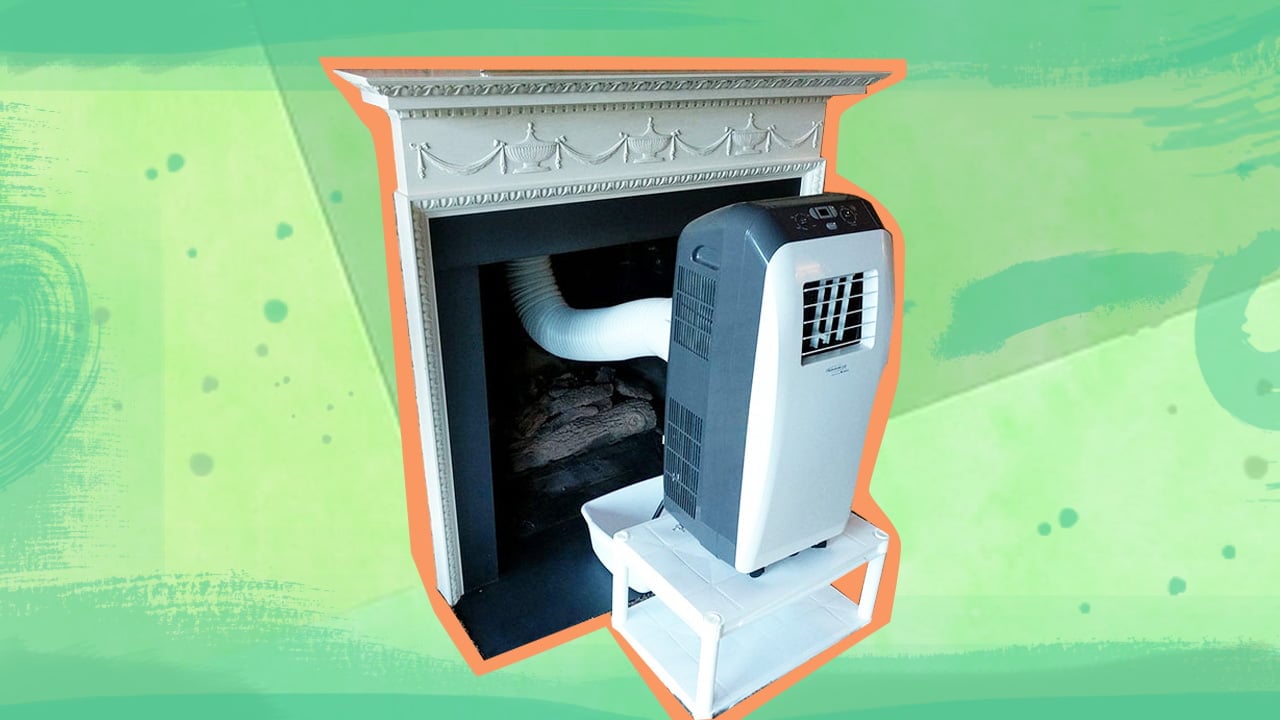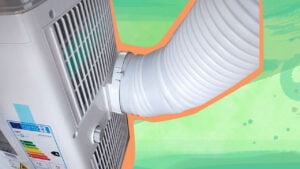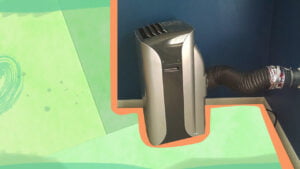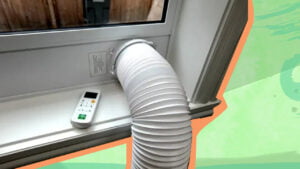A portable air conditioner is a standalone cooling system that is designed to cool single rooms and can be moved around easily. For the portable device to function optimally, it has to be vented based on the layout of your home.

Have you been planning to purchase a portable air conditioner but don't know how to vent it? Or perhaps you already own one and need a better alternative for venting it. Whatever the case may be, I've got you covered.
This article discusses the importance of venting a portable air conditioner and how it can be done safely and effectively.
Importance Of Venting A Portable AC

Before I begin with how you can vent portable air conditioners, let's look at why it is important to do so. Does not venting an air conditioner have any negative effects?
To answer briefly, yes, not venting your air conditioners can have negative consequences, the main being a dysfunctional air conditioning unit. To further understand this situation, let's look at how portable air conditioners function.
The main purpose of a portable air conditioning unit is to effectively cool a room or living space. However, the device needs to extract heat from the air to do that efficiently. This heat is then transferred outside so that your room stays cool for a long period.
When there are no vents for the air conditioning unit in another room or outside, it can result in the hot air being trapped inside the room. This will cause your air conditioner to cool the room much more slowly and result in your room being considerably warmer.
Furthermore, venting an air conditioner helps remove the excess moisture present in the air and keeps the overall humidity level regulated. The lower the humidity inside a room, the cooler the room gets. When there is no venting for the air conditioning, it causes the moisture levels to build up, thus minimizing the cooling effect of the AC system.
Venting allows your device to function at its maximum capacity, keeping the temperature in the room cool and comfortable at all times.
Types Of Portable Air Conditioner Vents
Portable air conditioning vents can be found in many different types. Some common ones are:
1. Sliding Windows And Sliding Door Vents
Most traditional windows and brackets are designed to be mounted horizontally at the bottom of the window. However, if you have sliding windows or sliding doors, these window brackets can be mounted vertically. Though it may require you to make minor modifications to accommodate the window brackets and ensure a snug fit, it is a simple process to install them on a sliding window.
In the case of sliding windows, you must ensure that the window bracket is long enough to fit the window opening. Air conditioners comprising double window brackets are usually the best for sliding windows.
Double window bracket units come with a standard window bracket and a second filler bracket. Once the bracket is fully set up, you can seal any opening with either Plexiglass, wood, insulation, or other filler materials.
For portable air conditioners with a single-window bracket, you will notice a significant amount of space between the window unit. This can also be filled up similarly using plywood or Plexiglass.
Furthermore, installing a portable air conditioner vent onto a sliding window is beneficial for people who need a temporary venting system. You can install it during the summer and take it off once you don't use the AC anymore in winter.
2. Casement Window Vents
Casement windows and crank windows usually open similar to doors. Due to this, a standard window kit or bracket will not work for them, but there are ways around this.
To install a portable air conditioner onto the casement windows, you must first detach the whole window from the window frame. Once the window is removed, replace it with either plastic or wood.
After replacing the casement windows with a more solid surface, you can vent a portable air conditioner as you would with sliding windows. Finally, connect the window kit to any empty space near the window.
Though it is more time-consuming, it allows you to properly vent your air conditioner regardless of what type of window you own.
Ideal Location For Venting An Air Conditioner
Finding the right location to install portable air conditioner vents is crucial for every home. Vent placement seems like a straightforward approach, but there are certain factors that most homeowners don't consider.
Placing the portable unit vents near or within the ceiling panel is an ideal option if you're looking for energy efficiency. When the vents are placed near the ceiling, air circulation increases and air moves faster through the rooms.
This allows the room to be cooled almost instantly, so you won't have to use your air conditioner for prolonged periods. Additionally, the dust and debris fall to the ground, which minimizes the chance of these vents being clogged.
If you're concerned about your carbon footprint or your AC power consumption, a ceiling vent is a way to go. When portable air conditioners vents are located near the floor, the furniture inside the room can end up blocking the vents. This leads to the hot air getting trapped inside the room and thus causing the room to cool slowly and stay on the warmer side.
Moreover, it decreases the air conditioning system's efficiency and pushes it to work twice as hard to cool the room. Placing air conditioner vents near the floor can also lead to the accumulation of dust and debris, which ultimately forms a clog. This lowers the airflow within the room and may even lead to mold and mildew growth, resulting in a major health hazard.

How To Install A Vent Kit
Using a window kit for your portable air conditioning unit is an effective solution for setting up a portable unit.
The installation instructions can vary based on the type of vent kit used and the surface on which the venting will be done. Generally, it is best to refer to the instruction manual on the vent kit itself since each kit has its own set of requirements.
However, we'll go over some steps to give you a general idea of what needs to be done while installing a venting kit.
To vent your portable air conditioning unit through a sliding window, you'll have to ensure that the window is the right height for the exhaust hose to fit. Thus, you must measure the window and the vent kit.
Next, install the window kit to the open space in the window, keeping in mind that they must form a tight seal. This prevents air leaks and stops the hot air outside from making its way into your cool room. Plus, not sealing the vent properly can lead to insects and other small bugs crawling through the space between the vent kit and the window.
Finally, attach the AC exhaust hose to the window kit and connect the vent kit to the window.
Alternative Venting Options
Venting a portable air conditioner is not always easy or possible, especially when vented through a regular window to cool rooms located far inside your house. In such cases, you'll have to find other venting alternatives.
1. Venting Through The Door
If your room needs cooling and comprises a door leading to another free space, this can be a foolproof solution for venting your portable air conditioner.
However, this might not work if the door leads to another living space. The room that would be vented to would have higher temperatures, so a room used minimally is a better choice.
This might not be a problem when you vent directly outside, but these increased temperatures can lead to several issues in another room within the house. Since the portable air conditioner venting will push heat into the room, ensure that the room is empty. At the very least, ensure that there are no items in the room that can be destroyed by the sudden spike in temperature.
If there are no alternatives but to vent the portable air conditioner to another living space, find ways to dissipate the heat. It can either be a window or an exhaust which can help push out the excess heat and keep the room temperature moderately regulated.
Moreover, you will have to minimize the air transfer because of the unconditioned and conditioned areas. Making use of a door or window sealant would help prevent air leaks and stops unwanted heat from getting into the room that is being cooled. The seal also covers the large opening when you vent a portable AC through a door.
2. Venting Through The Drop Ceiling
Yet another effective portable air conditioner venting technique is through an access panel or ceiling tile. To vent your portable air conditioning system through the access panel, you will first have to make a hole in the panel. This will create a space for the exhaust hose to be installed properly. You can also make use of a venting kit to cut the access panel till there is enough space for the exhaust hose.
When venting a portable air conditioner to the attic or ceiling, perform the entire ceiling venting process carefully. Being mindful of the humidity levels and temperature in the ceiling is also necessary. When there is excess warm air and humidity in the attic, it can cause the entire house to heat up.
An ideal way to combat this issue is by installing an exhaust hose or fan. This will exhaust hot air from the attic and keep the moisture or humidity levels under control.
3. Venting Through The Dryer Vent
Though it is possible, attaching a portable AC unit exhaust vent hose to a dry vent isn't necessarily the ideal solution. This is mainly because a dryer vent has a smaller diameter when compared to an air conditioner vent hose.
Attaching a larger vent hose to an air conditioner makes the air conditioner work much more than it usually would to get rid of excess heat from a room. This can become worse due to a flap inside the dryer vent.
On average, portable air conditioners are not extremely powerful. This limits their ability to blow air strong enough to open the flap of the dryer vent. In case you do end up venting your portable air conditioner through a dryer vent, ensure that it comprises a screen instead of a flap.
Though this method does work to a certain degree, there are still better alternatives to efficiently vent your portable air conditioner.
4. Venting Through The Wall
Portable air conditioner venting through the wall can be used as a last resort when you run out of other alternatives. A wall vent can be used to transfer the hot air outside or to another room, such as a garage or storage room.
To vent a portable AC unit through the wall, you can carve a hole that is accurately sized with the help of a jigsaw. Before you proceed with cutting the hole, ensure that the area you're about to cut does not contain any electrical wiring or plumbing.
Once the hole is cut, seal the edges with the help of silicone caulk. However, this method is unfavorable for various reasons. The main reason is that the walls will get damaged when cutting the hole.
This is not only labor intensive but also has the potential to go wrong. Secondly, when you vent warm, moist air through the walls, they can develop severe water damage, which in turn ruins the appearance of the entire surface.
Is It Possible To A Vent Portable AC Through A Screen?
To vent a portable AC unit through a screen isn't necessarily the most efficient option. No matter how well you install the vents, venting through a screen can reduce the efficiency of your air conditioning unit. However, in certain scenarios, this method can work exceptionally well.
Generally, you would have to detach the screen to vent a portable air conditioning unit through the window. But in some situations, detaching the screen is not possible.
Before venting a portable AC unit through the screen, ensure it is clean because if it is dirty, it can cause the airflow to drop and decrease your air conditioning unit's efficiency. You would also need to take into account the screen type that you'll be using. If the screen is thin, it can improve the airflow rate, whereas thicker screens do the opposite and reduce it.
To know if the screen is of the right thickness, test it by looking through it. In case you can see clearly through the screen, it would be sufficient to vent a portable air conditioner.
Is It Possible To Vent A Portable Air Conditioner Through A Return Vent?
For venting portable air conditioners, using a cold air return vent is usually not the best option. Venting your portable air conditioning system through a portable AC vent makes the machines work twice as hard.
As the portable air conditioner pushes heat further into the return vent, it travels back to your home's central air conditioning system. Additionally, your central air conditioning unit will be required to work equally hard to eliminate the room's excess heat.
Basically, all air conditioners in your home would be working more than they normally would just to eliminate heat from within the room that they're supposed to cool.
However, if this option is your last resort, it can be beneficial to a certain extent. Given that your home's central air conditioning system can cool the room and remove heat, this method would cause no further problems.
Before you decide on a venting option, it would be best to consult an HVAC specialist so that they can provide you with the right advice.
Whatever the case may be, venting your portable air conditioner through the return vent should only be done if there are no other options available. It should also be considered a temporary fix until you figure out a more permanent solution of venting your portable air conditioner.
How To Maintain Your Venting System
Like most things, the venting system of your air conditioner tends to become dirty over time. However, it should not be neglected and has to be cleaned regularly to keep the vents safe from mold growth and preventing vent clogs.
Cleaning the vents of your air conditioner is fairly easy. The quickest way it can be done is by using a handheld vacuum over the vent to suck all the dirt and debris.
On the off chance you do not own a handheld vacuum, you can use a small cleaning brush. This gives you much more control and precision than the vacuum and allows you to clean each nook and cranny of the air vent.
When you clean a ceiling vent, the dust and debris from the air vent can get into your eyes and nose, so use proper protective gear and cover them appropriately.
The air vents of most portable air conditioners can be cleaned as frequently as you see fit. Most homeowners tend to clean the air vents in their homes every four to six months. However, if you have allergies, cleaning them every month would be best.
A clean air vent can prevent dust and other particles from making their way into your home and causing lung problems or other respiratory issues. Keeping the vents clean also reduces the chance of potential damages that may call for expensive repairs and services.
Tip
Apart from cleaning the air vents, you must check them for any air leaks. Air leaks can cause the hot air to flow back into the house, making the air conditioner much less effective. If you find any air leaks, seal them immediately with high-quality sealants.

Conclusion
As you may know, venting your portable air conditioner is more of a necessity than an option. Since a portable air conditioner works with or without windows, they are extremely versatile and this feature also broadens the venting options for these devices.
If the above-mentioned tips don't seem to work, use your creativity to find more practical ways to vent a portable AC unit. Or contact a professional technician to help you with the installation.
With that, I'll be signing off. I hope these tips make your life a whole lot "cooler."
Related Articles
10 Best Dual Hose Portable Air Conditioners
Best Portable Air Conditioner and Heater Combos
How To Hide Your [AC] Air Conditioner Unit?
13 Quietest Portable Air Conditioners
9 Best Ventless Portable Air Conditioner
